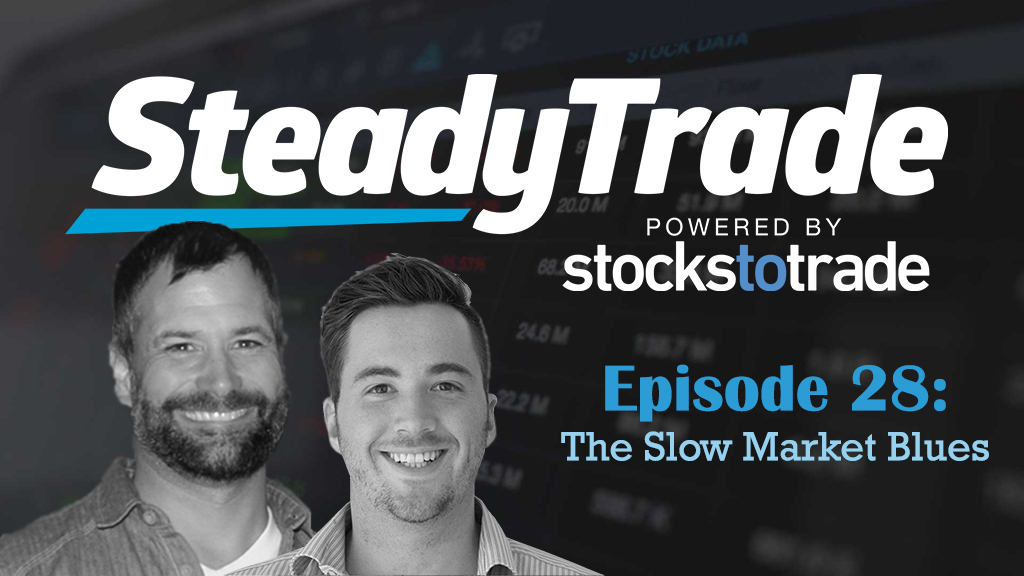It’s a simple fact: the market is ever evolving. The economy, time of year, and many other factors play into the ever-changing nature of stocks and how they perform. As a trader, these fluctuations can sometimes be scary and disorienting and cause a slow market.
On the Steady Trade Podcast, we’re always looking to bring as much value as possible to our listeners. Given the current state of the market, it’s the perfect time to discuss what traders should do when the market is slow.
What’s state of the market?
At the time of this recording, the market is extremely slow, particularly for low priced stocks. This is quite a shift after the crazy years that were 2016 and 2017, with their Bitcoin mania, cryptocurrencies running, and when it was not unusual to have 500 percent plus runners on a daily basis.
As a trader, times like this can be extremely frustrating, because setups and techniques that worked just months before are no longer delivering profits.
Circle of life–er, the market.
The good news is that these market cycles are normal. There was a two-year party, and now we’re in what host Tim Bohen calls “the hangover phase”. Things have slowed down, and this is only exacerbated by the fact that its earnings season (a notoriously quiet time in the market). It’s basically the perfect storm of stillness in the world of low priced stocks. Things could quiet for a bit before the market perks back up.
Overtrading in times like these can be terrible not only for your account but for your psyche. When things are booming, that is the time to overtrade. When the market is like it is now, you’re just going to kill yourself mentally and see your account grind down.
To trade or not to trade?
To paraphrase a quote from Jesse Livermore, “There’s a time to go long, there’s a time to go short, and a time to go fishing.” When the market is slow, sometimes the best action is actually…inaction. In the episode, Tim and Stephen discuss varying points of view on this and offer insight on how to decide whether or not you should take a break from actively trading during a slow market time.
Recognizing market changes.
One of the biggest keys to surviving slow times in the market? Simply having the wherewithal to recognize that the market has shifted. Particularly if you’ve been making reliable profits, the idea that your setups are no longer working can be a hard pill to swallow. Tim and Stephen offer some great tips on how to recognize and identify a market shift.
Adapting to the market.
Beyond simply recognizing market changes, Tim and Stephen offer a deeper discussion about how to know when it’s time to make a change in your trading based on the state of the market. They explain how you can start by monitoring your winning percentages, and offer techniques for adapting your methods to hopefully continue making money; Stephen, in particular, has a killer tip (learned the hard way, of course) about focusing on just one or two setups!
What should you look for?
Even in a slow market, there’s always some sort of opportunity out there. Tim and Stephen discuss what to look for in stocks that might remain profitable with Tim’s unique “recipe” for success. They also talk about how to know when it’s time to move on trades in a tougher market.
Always try to be better and stronger.
As much as you might not like it, the odds are always in the market’s favor. You’re not going to change the market by force of sheer will. However, you can continue to grow, evolve, learn, and get better. Tim and Stephen offer their personal tips for self-care and self-growth during slow times in the market. After all, you want to be ready when the market comes back around!
Ask us anything!
If you would like to hear more about anything discussed in this (or any) episode, be sure to visit the “submit your audio” section on our website to ask your question; it might just be featured on the air!
Thanks for tuning in to the Steady Trade Podcast! Stay tuned for weekly episodes covering every aspect of how to be a steady trader with long-term, reliable success!
Did you love this episode? Be sure to leave an iTunes review!




Great content and podcast. Tim your vocals could be your next career! Stephen – I think I have an extra shirt that would fit your style… Thank you both for the episode. Good info.
haha, thanks Rick!!
Tim, if that was you singing, it’s somewhat refreshing to know that you aren’t great at EVERYTHING you do! Still love the chemistry between you guys. Another great podcast; so much useful (and extremely timely) information!!! Thank you both!!
Yes it was me singing… and yes it was REALLY bad 🙂
hello Tim excellent performance, you remind me a little bit Johnny Cash.Tim I would have some questions about STOCK TO TRADE, where it is best to contact you
Thanks to you for listening Toquey!
Haha, I’m sure Johnny is rolling in his grave on that comment 🙂 but Thanks!!
Another excellent podcast guys but Tim shouldn’t give up his day job for a singing career 🙂
Also enjoyed the challenge webinar on Monday Tim, so thank you for the time to teach us.
Thank you very much guys
Hey if I practice daily I might be a average singer by the time I’m 150 years old 🙂
Thanks for the comments, and thanks for listening!
I loved your singing Tim!!! Lol. Like the music too. It’s nice and chill.
Thanks Katherine!! Though I’m not sure I believe you 🙂
Guys I am pretty sure the song Tim sang was based off a song ” You don’t have to call me Darling ” by David Alan Coe not Johhny Cash.
BTW how do you access Oracle I don’t see it on my startup menu in stockstotrade?
Yep David Allen Coe! Just open a new tab in STT then go to the “Oracle” icon, the pyramid with an eye. Then you will be able to access Oracle. Thanks
Great podcast! Financial freedom is the goal to enjoy the family on my own terms.
I was at the webinar when you called Michael Goode….hehe…he was confused and didn’t take the joke well…hehe…I thought it was hilarious… Anyway….Thank you again for the great tips and knowledge Tim and Stephen…I will be waiting for #29!
Ahhhhhhh golden nuggets of information once again – Can you please elaborate or confirm the idea of using orders for shorting at resistance. I was hoping Stephen could have explained the exact order type used as I left the great podcast a little unsure exactly how this is achieved?
My understanding is – I can use a (SHORT) SELL LIMIT order priced at resistance (higher price) and obviously if the price action doesn’t reach your limit price, it wont be executed or do I need to specify a different type of order?
Also, can you explain the term “wash?”
Thanks, in advance 🙂
Great Work Guys, Thanks